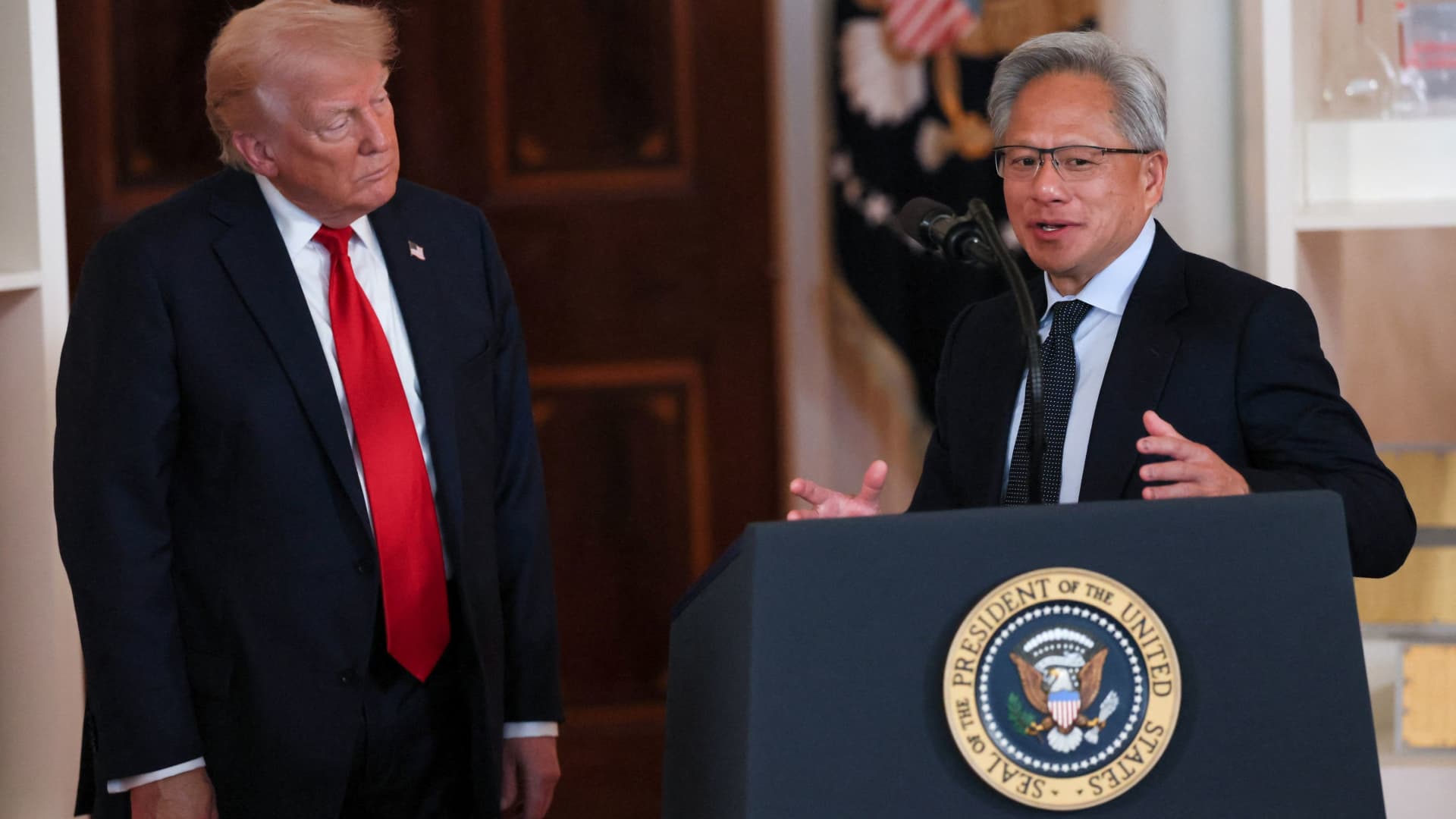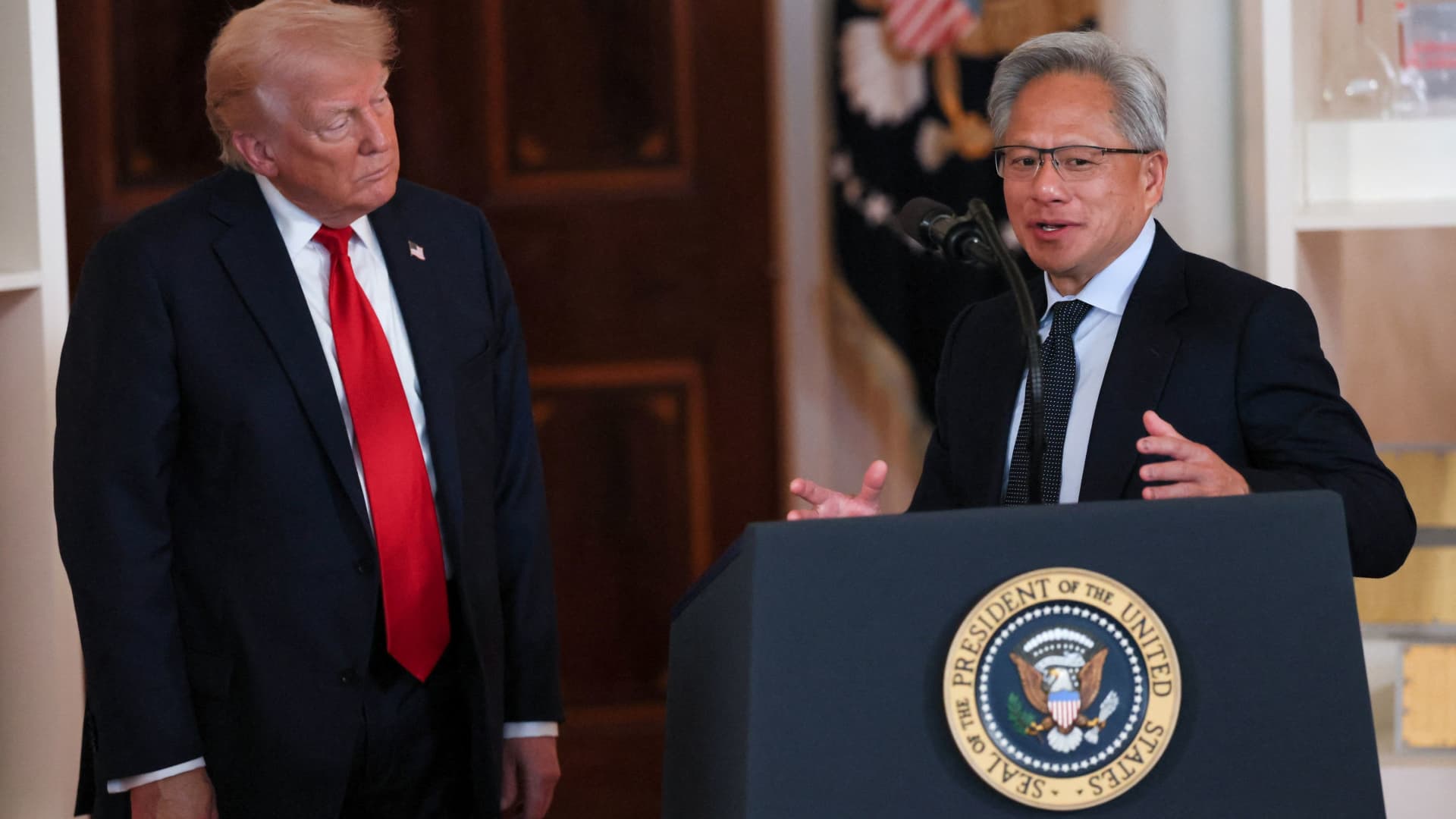Nvidia, a global leader in graphics processing units (GPUs) and artificial intelligence (AI) technologies, is at a critical juncture. The company’s CEO, Jensen Huang, recently met with former President Donald Trump at the White House, just before a scheduled trip to China. This meeting comes as Nvidia briefly surpassed a $4 trillion market capitalization, a milestone unmatched by any other company. The convergence of these events underscores the intricate geopolitical and economic dynamics shaping Nvidia’s future and the broader tech industry.
A Strategic Meeting: Nvidia and the White House
The meeting between Jensen Huang and Donald Trump is fraught with implications. While the specifics of their discussion remain private, the broader context provides valuable insights. Trump’s administration has historically emphasized domestic manufacturing and technological sovereignty, aligning with Nvidia’s investments in U.S.-based chip production. Huang has publicly committed to manufacturing advanced AI chips in the United States, a move likely to resonate with Trump’s priorities.
The timing of the meeting is also significant, occurring amid escalating trade tensions and concerns over China’s technological advancements. Nvidia’s high-performance chips are pivotal for AI development, and the U.S. government has imposed stringent export controls on such technologies to China. The meeting may have served as a platform to discuss export regulations, tariffs, and the delicate balance between fostering innovation and protecting national security.
Trump’s past rhetoric on tariffs and protectionist trade policies suggests that Huang sought to gauge Trump’s stance on these issues. Nvidia’s global operations depend on favorable trade policies, and Huang likely aimed to advocate for policies that support both U.S. technological leadership and Nvidia’s international business interests.
Balancing Act: Nvidia’s Engagement with China
Huang’s impending trip to China adds another layer of complexity to Nvidia’s strategic positioning. China is a critical market for Nvidia, accounting for a substantial portion of its revenue. However, U.S. export restrictions have compelled Nvidia to adapt its products for the Chinese market, such as the development of the H20 AI chip, designed to comply with U.S. regulations.
The meeting with Trump just before Huang’s China visit suggests a coordinated effort to ensure that Nvidia’s engagements in China align with U.S. strategic interests. Huang’s trip is likely aimed at strengthening relationships with Chinese partners and exploring new opportunities for collaboration. However, he must navigate the political sensitivities and risks associated with operating in China, including intellectual property concerns, regulatory uncertainties, and competition from domestic Chinese chipmakers.
China’s leadership in AI adoption and deployment makes it an indispensable market for Nvidia. The country’s investments in AI infrastructure and its growing demand for advanced AI technologies present significant opportunities for Nvidia. However, the geopolitical tensions between the U.S. and China could pose challenges, requiring Nvidia to carefully balance its business interests with geopolitical realities.
The $4 Trillion Milestone: A Testament to Nvidia’s Vision
Nvidia’s brief achievement of a $4 trillion market capitalization is a testament to its long-term vision and strategic execution. This milestone is not merely a reflection of short-term market sentiment but a validation of Nvidia’s leadership in AI and GPU technologies.
Nvidia’s success is underpinned by its dominance in AI training and inference, with its GPUs and software platforms like CUDA becoming industry standards. The company’s diversification into data centers, automotive, and professional visualization has further strengthened its market position and resilience. The explosive growth of AI across various industries, including cloud computing, autonomous vehicles, healthcare, and finance, has driven demand for Nvidia’s products.
Analysts predict continued growth for Nvidia, citing the sustained AI boom and the company’s strong competitive position. Some even speculate that Nvidia could be among the first companies to reach a $5 trillion or even $10 trillion market cap in the coming years. However, this growth trajectory is not without challenges.
Challenges and Opportunities on the Horizon
Despite its impressive success, Nvidia faces several challenges. Intensifying competition from AMD, Intel, and numerous startups threatens its market share in the AI chip sector. Geopolitical tensions could disrupt Nvidia’s supply chain or limit its access to key markets, particularly China. Rapid technological advancements could render current products obsolete if Nvidia fails to innovate.
However, Nvidia also has significant opportunities. The demand for AI chips is expected to grow rapidly in the coming years, driven by the increasing adoption of AI across industries. Nvidia’s substantial investments in research and development position it to stay ahead of the curve. Its strong brand reputation and established customer relationships provide a competitive advantage over its rivals.
The AI Imperative: Shaping the Future
Nvidia’s story is intrinsically linked to the broader AI revolution. As AI continues to transform industries and society, Nvidia’s role as a key enabler of AI technology becomes increasingly critical. From powering self-driving cars to enabling breakthroughs in drug discovery, Nvidia’s chips and software are at the heart of countless AI-driven innovations.
The AI revolution presents both immense opportunities and significant challenges. It has the potential to improve productivity, create new jobs, and solve some of the world’s most pressing problems. However, it also raises concerns about job displacement, bias in algorithms, and the ethical implications of AI-powered weapons and surveillance systems.
Conclusion: A Pivotal Moment for Nvidia and the World
Nvidia’s recent meeting with Donald Trump, coupled with its impending trip to China and the $4 trillion market cap milestone, represents a pivotal moment. It highlights the complex interplay between technology, geopolitics, and economics in the 21st century. Nvidia’s success is a testament to its technological prowess and its ability to navigate the ever-changing global landscape.
As Nvidia continues to push the boundaries of AI and shape the future of technology, its actions will have far-reaching consequences for businesses, governments, and individuals worldwide. The stakes are high, and the world is watching. Nvidia’s ability to balance its business interests with geopolitical realities will determine its long-term success and its impact on the global tech industry.












